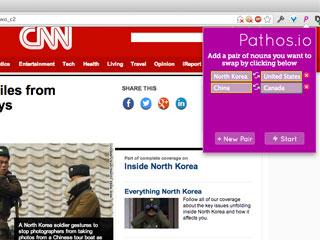Pathos.io is a suite of tools to help users understand media bias and their own bias through textual manipulation. By playing with perspectives and nouns, Pathos.io aims to inspires empathy in the reader for those being written about.
Background
I was strongly inspired by the work of Julian Oliver and Daniil Vasiliev on Newstweek as well by the work of The Yes Men on the New York Time's Special Edition. Even before I came to ITP I was interested in the power of text and language over diplomacy and politics when I created Tonaleak, a sentiment analysis marked up copy of the Wikileaks documents.
While working on this project I consulted faculty in the linguistics department, as well as other classmates with considerable Natural Language Processing experience. I knew from my past experiences that NLP was the correct way of doing what I wanted to, but wasn't sure if it was the way I needed to go.
Implementation
The work work lives in two components, a client side Google Chrome Extension and a server side application that can recognize the client side's creation, save it and serve it up later.
The Google Chrome Extension functions in three (or four) stages:
1) User initiation and noun selection. The user activates the plug in and creates a list of the noun groups that they will be swapping by selecting from an available selection of noun groups.
2) Activation, searching and tagging. On the users order, the extension searches the page for nouns associated with the noun groups they selected, as defined by a complex and hidden list of Regular Expression terms and normal strings. Once found the application places the terms inside a tag that indicates the term is a certain type of noun.
3) Replacement. Following the tagging, the application searches for the tags and constructs the appropriate replacement noun by looking up the opposite pair's noun structure.
4) Sharing. If the user elects, the noun list and the site's URL are sent to a central server and recorded. Once the server acknowledges the information it responds with a unique URL that would automatically present the page with the terms swapped out. This unique URL is used to share and spread the created page.
The server side application functions much like the Chrome Extension except in that all creations are initiated through the extension rather than through a web-based interface on the server. The server also tallies the number of unique views for each 'creation' and serves a 'Most Popular' list.
Background
I was strongly inspired by the work of Julian Oliver and Daniil Vasiliev on Newstweek as well by the work of The Yes Men on the New York Time's Special Edition. Even before I came to ITP I was interested in the power of text and language over diplomacy and politics when I created Tonaleak, a sentiment analysis marked up copy of the Wikileaks documents.
While working on this project I consulted faculty in the linguistics department, as well as other classmates with considerable Natural Language Processing experience. I knew from my past experiences that NLP was the correct way of doing what I wanted to, but wasn't sure if it was the way I needed to go.
Implementation
The work work lives in two components, a client side Google Chrome Extension and a server side application that can recognize the client side's creation, save it and serve it up later.
The Google Chrome Extension functions in three (or four) stages:
1) User initiation and noun selection. The user activates the plug in and creates a list of the noun groups that they will be swapping by selecting from an available selection of noun groups.
2) Activation, searching and tagging. On the users order, the extension searches the page for nouns associated with the noun groups they selected, as defined by a complex and hidden list of Regular Expression terms and normal strings. Once found the application places the terms inside a tag that indicates the term is a certain type of noun.
3) Replacement. Following the tagging, the application searches for the tags and constructs the appropriate replacement noun by looking up the opposite pair's noun structure.
4) Sharing. If the user elects, the noun list and the site's URL are sent to a central server and recorded. Once the server acknowledges the information it responds with a unique URL that would automatically present the page with the terms swapped out. This unique URL is used to share and spread the created page.
The server side application functions much like the Chrome Extension except in that all creations are initiated through the extension rather than through a web-based interface on the server. The server also tallies the number of unique views for each 'creation' and serves a 'Most Popular' list.



